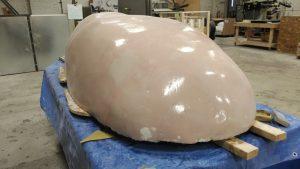Rensselaer Polytechnic Institute (RPI), is a private research university and space-grant institution in Troy, New York. Since 2007, the Rensselaer Electric Vehicle (REV) team has given Rensselaer students the opportunity to explore their engineering interests in an exciting, hands-on manner. They work to build hyper-efficient battery-powered electric vehicles from the ground up, and compete for efficiency alongside teams from around the world at competitions such as Shell Eco-Marathon (SEM) and Electrathon America. We gladly helped them out when they came to us to find a lightweight, LiFePO4 solution for their competing electric vehicle, Leo. Blair Montgomery of the REV team has written us a guest article to speak more on the process of their project. Enjoy.
“Looking over their product reviews, it became readily apparent that we could rely on Dakota to supply a safe and reliable battery. One of the main benefits of using a Dakota battery is that they are resilient under higher operating temperatures.”
Meet Leo: The High Performing Electric Vehicle Powered by Dakota Lithium Batteries
Leo is a light-weight prototype electric vehicle built to compete in the Shell Eco Marathon (SEM). SEM is a race for efficiency, not speed, so Leo has been built first and foremost to be lightweight and aerodynamic, with minimal transmission losses.

Leo’s Aerodynamic Flow
Choosing Dakota Lithium
Dakota’s lithium batteries met both Shell’s and our specifications for power and BMS systems, in addition to the staff at Dakota being accessible and friendly. Looking over their product reviews, it became readily apparent that we could rely on Dakota to supply a safe and reliable battery. One of the main benefits of using a Dakota battery is that they are resilient under higher operating temperatures. Heat build-up in our rear cabin is a concern for us as we run our motors at a high-speed for an extended period, meaning this battery is ideal for our use-case. In addition, because we are making our own motor controller, a comprehensive BMS such as the one Dakota batteries supply are exactly what we need. With the danger an improperly managed Li-ion battery can pose, it is paramount that any BMS we consider handles cell-balancing and ensure that the battery is operating within safe ranges. Dakota batteries provide that functionality, ensuring that we can test our car and its new circuitry with confidence.

Leo’s Body Mould
Creating a Light-Weight Electric Vehicle
To minimize weight, Leo has a monocoque chassis. Using a monocoque allows the body to function as a chassis, saving weight over a normal chassis. The body is made of Nomex, carbon fibre, and epoxy resin. These materials were chosen for their ability to provide structural support whilst still being light-weight. To choose the shape of the body, several designs were run through a drag-simulation. More successful designs were iterated upon until we reached our final design for the body.
Now that we have a body design, we are in the process of manufacturing. With the body designed, we created a giant mould out of foam. This mould was then covered with automotive body filler and then sanded down to a smooth finish. After this step, epoxy resin and parting wax were applied to the mould.
Our next steps are to vacuum form the mould and create a female mould of the body. Using this female mould we can start laying the carbon-fibre, Nomex, and resin. We can then begin assembling these formed pieces to create the larger body. Once the body is complete, we can begin mounting the steering system and rear-wheel assembly.

3D Mock Up of Leo’s Steering Mechanisms
 Steering
Steering
The steering system is designed to be light and modular. Instead of a heavy rack and pinion system attached to the steering column, Leo uses a simple lever that moves the tie rods to rotate the wheels. The wheels themselves are covered by the chassis with deep wheel wells. This redirects air-flow around the wheels of the vehicle and reduces the drag that a non-covered wheel would create. Various parts of the steering system are adjustable to account for variances in body shape and allow for later optimization.
Leo will utilize a custom-made BLDC motor controller. Leo is currently designed to run at 36 V, but a future iteration will run at 48 V. We currently have a 36 V design that uses a TI DRV to drive the MOSFETs that drive our motor’s stators. We are currently designing a 48 V BLDC motor controller, which will no longer use TI’s DRV, meaning we need to implement all its functionality by adding individual voltage regulators and gate drivers in its place.